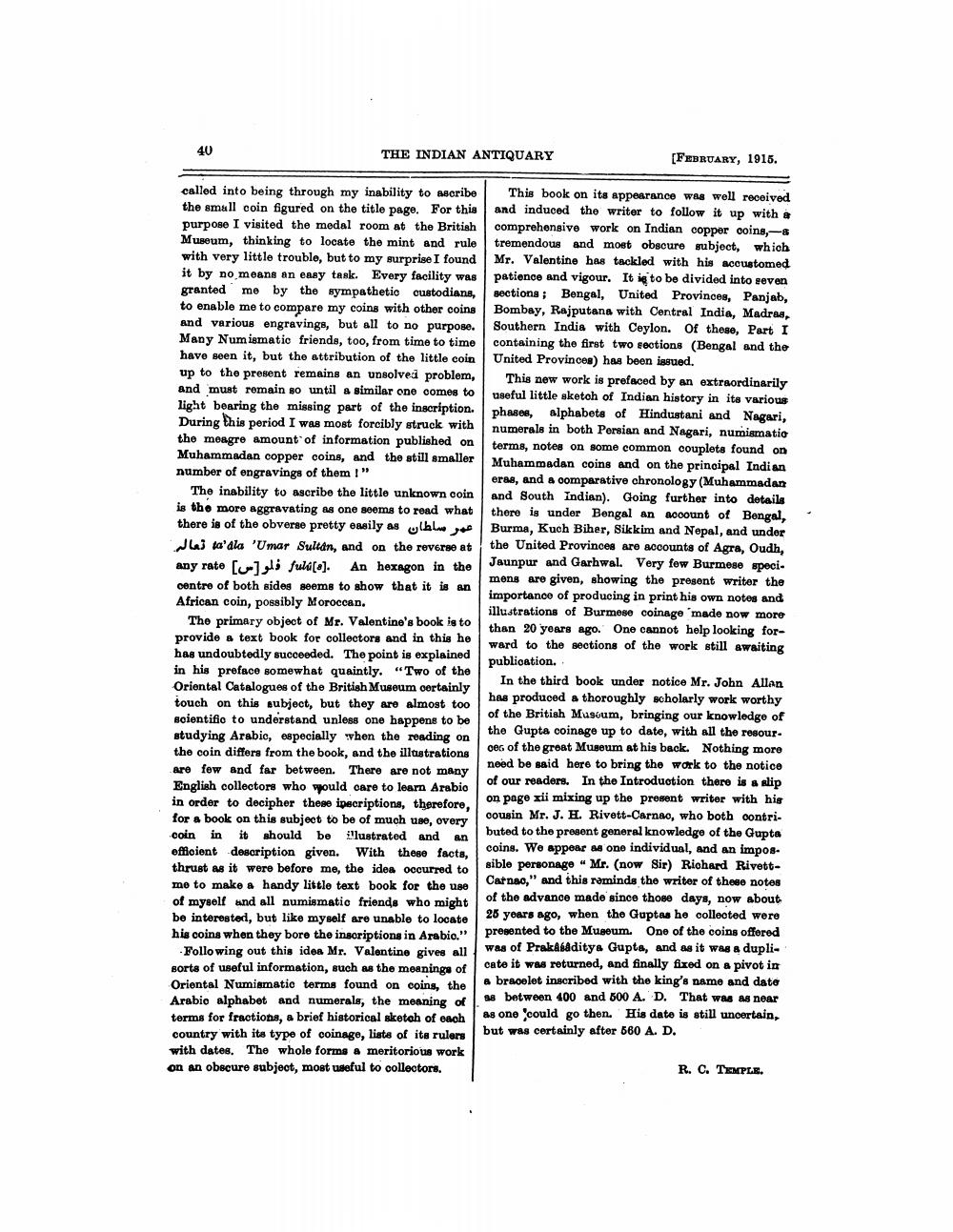________________
40
THE INDIAN ANTIQUARY
called into being through my inability to ascribe the small coin figured on the title page. For this purpose I visited the medal room at the British Museum, thinking to locate the mint and rule with very little trouble, but to my surprise I found it by no means an easy task. Every facility was granted me by the sympathetic custodians, to enable me to compare my coins with other coins and various engravings, but all to no purpose. Many Numismatic friends, too, from time to time have seen it, but the attribution of the little coin up to the present remains an unsolved problem, and must remain so until a similar one comes to light bearing the missing part of the inscription. During this period I was most forcibly struck with the meagre amount of information published on Muhammadan copper coins, and the still smaller number of engravings of them !"
The inability to ascribe the little unknown coin is the more aggravating as one seems to read what there is of the obverse pretty easily as the Ja ta'ala 'Umar Sultan, and on the reverse at any rate [] fulû[8]. An hexagon in the centre of both sides seems to show that it is an African coin, possibly Moroccan.
The primary object of Mr. Valentine's book is to provide a text book for collectors and in this he has undoubtedly succeeded. The point is explained in his preface somewhat quaintly. "Two of the
Oriental Catalogues of the British Museum certainly touch on this subject, but they are almost too scientific to understand unless one happens to be studying Arabic, especially when the reading on the coin differs from the book, and the illustrations are few and far between. There are not many English collectors who would care to learn Arabic in order to decipher these inscriptions, therefore, for a book on this subject to be of much use, overy coin in it should be illustrated and efficient description given. With these facts, thrust as it were before me, the idea occurred to me to make a handy little text book for the use of myself and all numismatic friends who might be interested, but like myself are unable to locate his coins when they bore the inscriptions in Arabic."
an
Following out this idea Mr. Valentine gives all sorts of useful information, such as the meanings of Oriental Numismatic terms found on coins, the Arabic alphabet and numerals, the meaning of terms for fractions, a brief historical sketch of each country with its type of coinage, lists of its rulers with dates. The whole forms a meritorious work on an obscure subject, most useful to collectors.
[FEBRUARY, 1915.
This book on its appearance was well received and induced the writer to follow it up with a comprehensive work on Indian copper coins,-a tremendous and most obscure subject, which Mr. Valentine has tackled with his accustomed patience and vigour. It ię to be divided into seven sections; Bengal, United Provinces, Panjab, Bombay, Rajputana with Central India, Madras, Southern India with Ceylon. Of these, Part I containing the first two sections (Bengal and the United Provinces) has been issued.
This new work is prefaced by an extraordinarily useful little sketch of Indian history in its various phases, alphabets of Hindustani and Nagari, numerals in both Persian and Nagari, numismatio terms, notes on some common couplets found on Muhammadan coins and on the principal Indian eras, and a comparative chronology (Muhammadan and South Indian). Going further into details there is under Bengal an account of Bengal, Burma, Kuch Biher, Sikkim and Nepal, and under the United Provinces are accounts of Agra, Oudh, Jaunpur and Garhwal. Very few Burmese specimens are given, showing the present writer the importance of producing in print his own notes and illustrations of Burmese coinage made now more than 20 years ago. One cannot help looking forward to the sections of the work still awaiting publication.
has produced a thoroughly scholarly work worthy In the third book under notice Mr. John Allan of the British Museum, bringing our knowledge of the Gupta coinage up to date, with all the resour oes of the great Museum at his back. Nothing more need be said here to bring the work to the notice of our readers. In the Introduction there is a slip on page xii mixing up the present writer with his cousin Mr. J. H. Rivett-Carnac, who both contributed to the present general knowledge of the Gupta coins. We appear as one individual, and an impossible personage" Mr. (now Sir) Richard RivettCarnac," and this reminds the writer of these notes of the advance made since those days, now about 25 years ago, when the Guptas he collected were presented to the Museum. One of the coins offered was of Prakasaditya Gupta, and as it was a duplicate it was returned, and finally fixed on a pivot in a bracelet inscribed with the king's name and date ss between 400 and 500 A. D. That was as near as one could go then. His date is still uncertain, but was certainly after 560 A. D.
R. C. TEMPLE.




